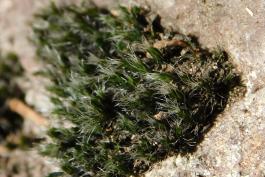
Silver beard moss grows on dry, exposed rocks, forming tight, dark grayish-green pads. To the touch, it has a coarse texture. Each leaf tip extends into a long, white hair that is half as long as the leaf itself and slightly curved. These hairs add a silvery cast to this otherwise dull moss, making it look smooth and soft.
The sporophyte capsules are partly covered by the leaves, so they may not be apparent unless you look carefully for them. The capsules develop and mature in springtime.
Learn more about Missouri’s mosses on their group page.
Similar species: Missouri has about 15 species of mosses in the grimmia family. Of these, the most commonly encountered is green schistidium, or common beard moss (Schistidium viride, formerly Schistidium apocarpum). It is quite similar to silver beard moss: It, too, is very common on dry rocks, but also on rock or concrete walls and other rocky surfaces. It is dark green to black and also has a coarse, dry texture. Unlike silver beard moss, however, it does not have white hairlike extensions of the leaf tips.
Forms cushions or tufts from about 1 inch in diameter, spreading to cover large, irregular patches on rocks.
Statewide.
Habitat and Conservation
Like most other members of its family, silver beard moss is almost always found growing on rocks. This species is usually found in rather dry, exposed situations, as on sunny rock ledges, tops of bluffs, and glades. Very common in the Ozarks, and often locally abundant.
Various species of Grimmia, along with Hedwigia spp., are among the characteristic plants of Missouri’s sandstone glade natural communities.
Status
Very common, in the correct habitats.
Life Cycle
As with other mosses, this species has alternating generations. The plant we usually think of as the moss is the gametophyte generation (it’s a gamete-, or sex-cell-bearing plant). In separate organs, it produces sperm and eggs. When water, even a thin layer of rainwater, is present, the sperm can swim to the eggs and fertilization occurs. The resulting offspring plant, called a sporophyte (spore-bearing plant), grows out of the female organs of the gametophyte.
In silver beard moss, the sporophyte takes the form of a capsule growing out of the tip of the gametophyte stem, often obscured by the surrounding leaves. It obtains nutrients from the gametophyte. When mature, the capsule opens to release spores, which can grow into new gametophyte plants.
Mosses also commonly reproduce asexually when a portion of the plant breaks away, gets moved elsewhere, and continues growing as a separate plant.
Human Connections
Although this moss definitely has a coarse texture when touched, the silvery hairs on each leaf tip give it the appearance of a mink coat. The scientific name means “smooth grimmia.” The genus name, Grimmia, honors the German botanist and physician Johann Friedrich Carl Grimm (1737–1821).
Ecosystem Connections
Usually, we think of mosses as living in shady, moist locations — and most do. But with this species, we find a moss that is adapted for the opposite. People sometimes like to think of the sciences as being full of absolute proofs and disproofs, but in the biological sciences, it’s often a matter of likelihood and percentages. In each group of organisms sampled, there are usually some individuals — or, in this case, species — that don’t fit the general rule.








Mosses, liverworts, hornworts, and lichens seem rather similar, but these organisms are in very different groups. Mosses, liverworts, and hornworts are small, low plants usually found in damp habitats. Unlike more familiar plants, they lack veinlike structures and do not produce flowers or seeds — instead, they produce spores. Meanwhile, lichens are not plants at all: they are a collection of different fungi that have photosynthetic algae living within their tissues.































